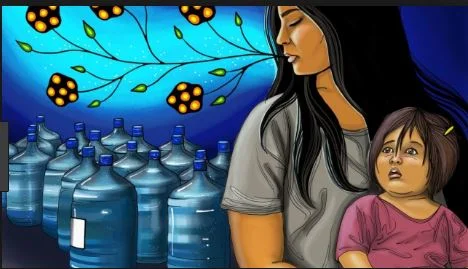“Water has to live, it can hear, it can sense what we’re saying, it can really, really speak to us. Some songs come to us through the water. We have to understand that water is very precious.” – Josephine Mandamin, Water Walker, 1942-2019
Water is one of the four elements that are very sacred to First Nations people. Many First Nations ceremonies involve water. These ceremonies include water walks, water ceremonies, sweat lodges, and fasts. These ceremonies will be described, videos about them will be watched, and a special type of discussion will be held.
Grades 6-9 Lesson 1: Medicine Wheel
“Water finds significance in the lives of First Nations people on personal, community, clan, national, and spiritual levels. Water is understood as a living force which must be protected and nurtured; it is not a commodity to be bought and sold.” - Unknown
All around Turtle Island (North America), the Medicine Wheel has been used as a teaching tool for many Indigenous Nations. Medicine Wheels consist of many different aspects that connect humans and all living things to the Earth.
Grades 3-5 Lesson 1: Respecting Our Water
“In order to respect the water we have to respect the land. The land is a natural filtration system for our water. We don’t take care of the land, the water becomes sick.” - Unknown
Students will be exposed to the protocol for approaching an Elder while learning the importance of respecting the water and land.
Grades 10-12 Lesson 4: The Tale of Shoal Lake 40
“It’s on the Manitoba-Ontario border, there are two First Nations involved, [the community] is not isolated, just south of the Trans-Canada Highway, it’s complex just getting there geographically, and incredibly complex getting there politically.” – Cuyler Cotton, Co-ordinator for both the Water Servicing and All Weather Road Projects
A century ago, the federal government expropriated land inhabited by the Shoal Lake 40 First Nation for construction of an aqueduct to provide water to the city of Winnipeg. Band members were moved onto a man-made island. Shoal Lake 40 has been under a boil water advisory since February 18, 1997.
Grades 10-12 Lesson 5: The Tale of Saddle Lake Cree Nation
“I’ve never seen a water supply in such poor shape! The lake is covered with blue greens, which make mats in nearshore areas. Yet this is a drinking water supply for several thousand First Nations people! This is a story that city people need to hear and see. They cannot imagine that we have water problems of this magnitude in Alberta.” – Dr. David Schindler
The community draws its water from Saddle Lake, which has 25-30 ppm of organics, as well as large algal blooms in the summer.
Grades 6-9 Lesson 4: Current First Nations Water Issues
“I think once we understand each other a bit more clearly, we can tell the rest of the people, this is what’s happening to our water and how to take care of it – because it’s taken care of us up till now.” – Violet Poitras, Nakota/Cree Elder, Paul First Nation
In 2015, Justin Trudeau campaigned on a promise to end all long-term drinking water advisories by March 2021.
K-2 Lesson 3: Ceremonial Uses of Water
“Water is what sustains us. Water is what brings us into this world, and water is what keeps us in this physical world. And so it’s our life.” - Jan Longboat
To help students understand how and why water was and is used in First Nations ceremonies. Specific ceremonies that will be looked at are the women’s water ceremony, fasting, sweat lodge, and giving thanks.
K-2 Lesson 4: Hydropower - Is it Bad or Good?
"We wouldn't be able to live without water. Nothing would." – Autumn Peltier
Energy, we all use it every day. We often hear that renewable sources of energy are better than non-renewable sources of energy. However, renewable sources of energy also have effects on the environment.
In this lesson, students will learn about hydropower and see the growth of their knowledge. They will also form an opinion on whether hydropower is bad or good.








